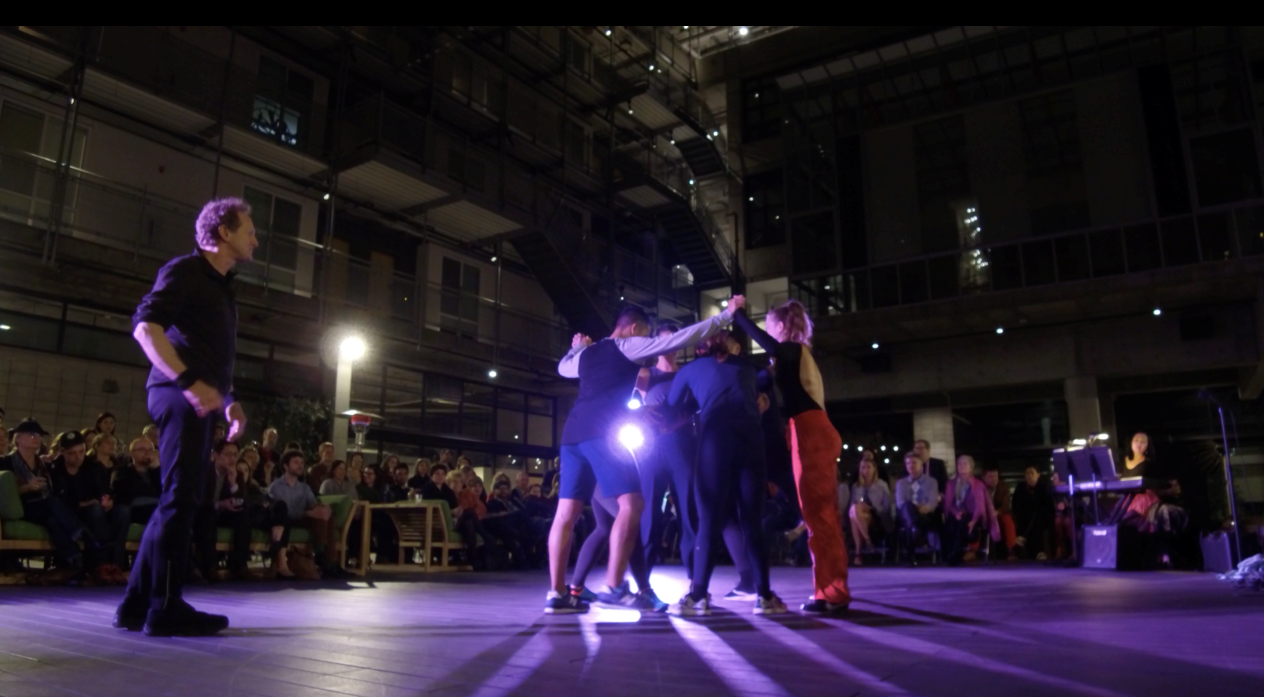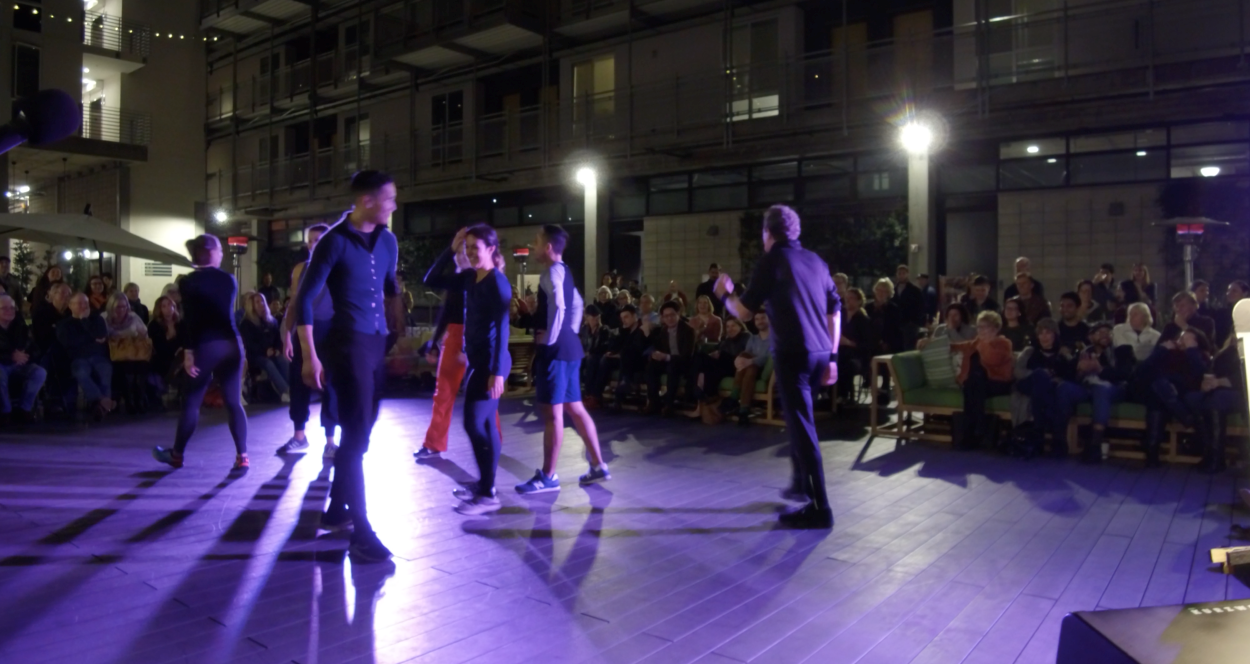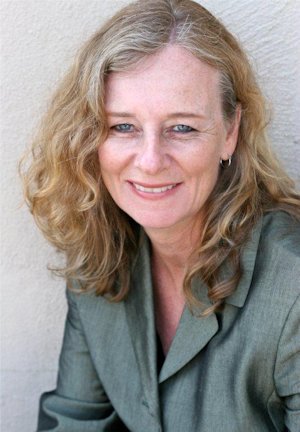Malashock Dance Shares Rare View of Choreographic Process for Symphony Festival
“It’s guarded, not shared, but tonight we pull back the curtain, to show work invented from scratch,” John Malashock said about Making Dance: The Future Starts Now.
The intimate event (Jan. 19) was part of Hearing the Future, the ambitious San Diego Symphony festival that explored a range of music and featured museums, theaters, and dance.

John Malashock and dancers created new choreography, set to music by Matthew Aucoin, and played by pianist Tina Chong. Image: Malashock Dance
“None of this is made up ahead of time,” Malashock said, as dancers joined him on the patio at IDEA1, “and they have not heard the music, by Matthew Aucoin, the festival curator. There he is.”
Aucoin, a composer and conductor and 2018 MacArthur Fellow and Genius Grant Award Recipient, sat with a curious audience on sofas and chairs, surrounded by sleek modern buildings.
For about an hour, we had a rare and rewarding view of the choreographic process. For many, it was an unknown dance experience–witnessing the choreographer, with his dancers, creating new movement on the fly.
Lean and limber in worn athletic pants, Malashock introduced pianist Tina Chong seated at an electric keyboard. He smoothed back his curly hair, took a breath, and his creative brain turned on.
“I’m doing trial and error,” he said with a grin, as Chong played a minor chord sequence. He looked down at the planked floor, pressed his palms together, and one foot rotated side-to-side. We heard deeper tones—bam bam—and could imagine a storm.
Listening along with us were the dancers: Sarah Emmons, Jennifer Fait Plus, Darren Oei, Marisa Shimano, Brittany Taylor, and Justin Viernes.
“Let’s pair you up, back to back, and start rotating around to the right, and then reverse,” Malashock said. “1-2-3-4-and a breath. I won’t make you count it.”
For the next section, they scooped hands upward out of a run and skipped backward. Boom–we had a phrase. Spin four times, step-ball-change, and Malashock demonstrated a leg swing. One left, one right, and fall forward, gallop. Any dancers in the audience couldn’t help but dance along, in between sips of wine and craft cocktails.
Malashock has worked in professional dance for 45 years. After a performing career with Twyla Tharp’s company in New York, he founded Malashock Dance in 1988. He’s proud of his dance school and outreach programs. He’s known for athletic choreography, more than 70 dance works, and collaborations with musicians, theaters, operas, and making dance films.
He understands anatomy and physics, and he’s fond of athletic lifts and tosses.
“The real grit here is the outside leg, so let her go,” he explained. “Catch her with straight legs, so by the time she jumps you are ready to catch her.”
After each new sequence, the dancers repeated the whole, which became a tricky game for viewers. How do they remember what comes next? Repetition.
“Bumb-da-di,” hummed Malashock, “and get together so there is more snap.”
Justin Viernes guided his partner Brittany Taylor in a walk over. Malashock asked other dancers for a chassé, a gliding step-together-step pattern. Repeat from the top. Repeat from the top.
In less than an hour, the dancers and dance maker had names for each sequence, and we marveled at their ability to remember it all.

John Malashock created a new dance work ‘on the spot’ in Making Dance: The Future Starts Now. Image: Malashock Dance
Near the end of the new-born dance, couples joined palm-to-palm, and Malashock had a vision.
“Make a triangle and fall inward, hmm, does this make sense?” he asked.
Within a few seconds the six dancers figured out how to run toward each other and rotate in two opposing circles.
“Don’t wait! He called out. The audience let out a communal sigh of approval. It was a strong move. “Let’s set a number of the rolling ins and outs…don’t think about stopping…let’s go…but we need a sense of acceleration. Faster. Faster.”
We heard scraping feet and a few giggles, but throughout the evening, dancers were focused and remained polite. On this cool January night, they peeled off layers of clothing from their steamy skin.
As Malashock listened and visualized, he admitted that he had jammed his dancers into a far side of the floor. Dancers were crouched in a line on a diagonal with their hands on shoulders of the dancer in front. Now what?
“Let’s take a cartwheel out of this!” He said. And he added a big toss, because Malashock likes dancers to run and jump into the air.
“She’s going to come flying out of here this way,” motioning with his hands like an airport man, “and guys, help her recover. Help get her some air.”
The dancers discussed strategy, and the petite Ms. Shimano ran into their web of hands. Malashock looked to us and smiled. From the top with piano again. The launch was a dud. Again. Again. But the final toss was a success and was timed with the sound of crashing music.
Watch a video clip of Making Dance: The Future Starts Now
We rooted for the dancers, and we tried to remember each ingredient for this new work invented from scratch: spirals, scoops, kicks, jump into it, partner, circle, circle, peel away, crouch, cartwheel, and launch!
After the bows, joyful audience members asked questions. Was there a narrative? No. Each viewer finds their own connection. What do you do when something doesn’t work? Dancers huddle and they try to make it work, but if it’s a disaster, forget it. How much do dancers contribute? A lot. How long does it take to create a big show? Months.
The composer Aucoin didn’t think it was possible for his music to work with dance, but was pleased how Malashock “rode” the piece. Malashock said we “rode the water currents of it.” Turns out the musical piece is titled “Currents.”
[Making Dance: The Future Starts Now, with Malashock Dance, was an event in partnership with Vanguard Culture, as part of its 2019 Season CATALYST.]
Hearing the Future festival explored music from the past and present. You can find in-depth coverage at SanDiegoStory.com by music critic Ken Herman.
In addition to Malashock Dance, Jean Isaacs San Diego Dance Theater presented Janus III Dancing the Future (Jan 25-27). The program included: two collaborations with bassist Robert Black and choreographer Katie Stevinson-Nollet; Lynchtown (1936), the chilling and seminal work by Charles Weidman, reconstructed by George Willis, who danced with the dance legend; and Shaker Loops (2019), a new work by Isaacs, set to a score by John Adams and spoken word written and performed by Meagan Marshall.

Kris Eitland covers dance and theater for Sandiegostory.com and freelances for other publications, including the Union Tribune and Dance Teacher Magazine. She grew up performing many dance styles and continued intensive modern dance and choreography at the Univ. of Minnesota, Duluth, and San Diego State Univ. She also holds a journalism degree from SDSU. Her career includes stints in commercial and public radio news production.
Eitland has won numerous Excellence in Journalism awards for criticism and reporting from the San Diego Press Club. She has served on the Press Club board since 2011 and is a past president. She is a co-founder of Sandiegostory.com. She has a passion for the arts, throwing parties with dancing and singing, and cruising the Pacific in her family’s vintage trawler. She trains dogs, skis, and loves seasonal trips to her home state of Minnesota.

Lovely Article.
Thanks, Kris.
Wish I could have been there!
Thanks for this inviting glimpse into another creative facet of the San Diego Symphony’s January festival. Seeing the clip of the dancers reacting to Matt Aucoin’s music shows how potent new music and contemporary dance can be when they interact.
Thank You Ken Herman for your reply, and the interview with Aucoin. He wears many hats. http://www.sandiegostory.com/matthew-aucoin-the-genius-behind-san-diego-symphonys-hearing-the-future-festival/
Will there be review of Janus?